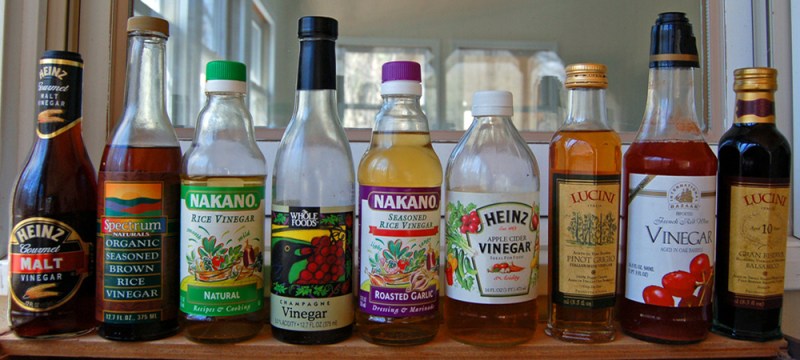Vinegar is a handy, healthy and versatile base ingredient that can be used in a wide variety of dishes. While there are many different types of vinegar, they all have something in common — the tartness.
Though the most common liquid base with which to make vinegar is wine, anything that is fermentable can be used to make it. Using vinegar in cooking is a centuries-old practice. Before it became a favorite foundation for marinades and dressings, it was used more practically — to preserve food through pickling.
Vinegar is not just used for food, either. It also can be used as an antiseptic; even the ancient Greek physician Hippocrates was known to use vinegar when treating patients. As a natural killer of germs, vinegar was actually one of the very first medicines available.
Here’s a directory of the different kinds of vinegar, plus some ideas for how they can be used, both in cooking and around the house:
Distilled White Vinegar

Distilled white vinegar is the most common type of vinegar. The transparent liquid is made from distilled grain alcohol and is used in some popular products, such as ketchup, bottled salad dressings and pickles. However, its flavor is sharp and unpleasant by itself.
White vinegar can also be used for cleaning because of its ability to kill germs. It has been proven to be highly effective in removing grease from surfaces and stains from clothing. It can even kill weeds in the garden. What’s more, it is all-natural and thus environmentally friendly, which is more than can be said for many other cleaning products.
Red Wine Vinegar
As you might guess, red wine vinegar is made from fermented red wine and is much milder in flavor than distilled vinegar. In the U.S., it is among the most popular kinds of vinegar and is a common ingredient in vinaigrettes, salad dressings and marinades for meats. Aside from the flavor blast, it contributes to many dishes, red wine vinegar is also healthy because it does not contain cholesterol, fat or sodium. It also has a ton of antioxidants.
White Wine Vinegar
Just as red wine vinegar is made from red wine, white wine vinegar is made from white wine. Its uses and properties are similar to those of red wine vinegar, including being a great base for salad dressings and marinades. It is also a useful cleaning product to use on multiple surfaces, including showerheads and sink taps.
Apple Cider Vinegar

Apple cider vinegar is another highly popular vinegar because of its more mellow flavor and a touch of sweetness. It’s made by pressing apples and letting them ferment into vinegar. Apple cider vinegar is commonly used in the cooking, particularly for dressings, marinades and sauces Its health benefits include relieving upset stomachs, sore throats and acid reflux, preventing indigestion, getting rid of bad breath and acne, controlling blood sugar, and giving you a boost of energy.
Rice Vinegar
Made from fermented rice wine, rice vinegar comes out with a sweeter flavor than most of its more acidic-flavored cousins. Rice vinegar is a staple in Chinese and Japanese cuisine, where it can be found in sauces, dressings, meats and vegetables. Plus, it doubles as a great cleaning agent.
Balsamic Vinegar

Aside from the delicious flavor that makes this Italian vinegar variety stand out, it is also the only vinegar that does not come from fermenting alcohol. It is made similarly to how wine is made, from pressed grapes, which are then aged. Also like wine, it tends to get more expensive as it ages because it becomes more complex and flavorful in the aging process. Balsamic vinegar is thick and sweet and can be used alone to drizzle on vegetables, in salad dressings or as a base of marinades.
Sherry Vinegar
Sherry vinegar, as the name suggests, is made from sherry, a type of fortified Spanish wine Though its flavor is stronger than traditional red wine vinegar, it is also used in dressings and various types of sauces.
Malt Vinegar
Malt vinegar is made from barley, and with its sweet, mildly acidic flavor, it is best used when dripped over a plate of fish and chips.
Black Vinegar

This smoky-flavored Chinese vinegar comes from unpolished rice and can take between one and three years to ferment. This process causes the vinegar to darken, its flavor and scent to ripen in intensity, and its content of vitamins, minerals and amino acids to rise. It is a staple sauce in Chinese and Japanese cuisine.
